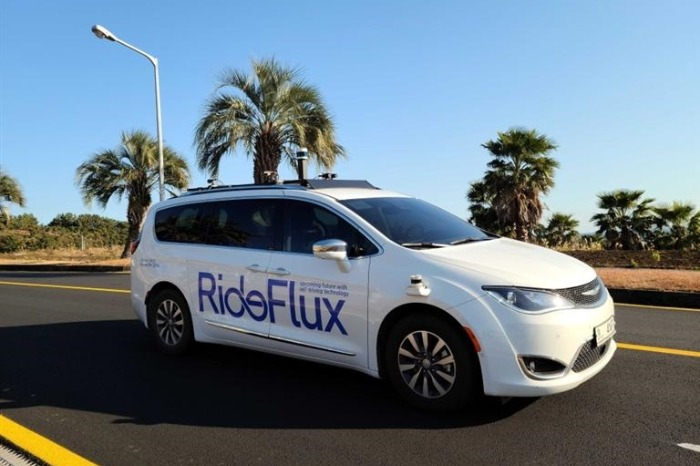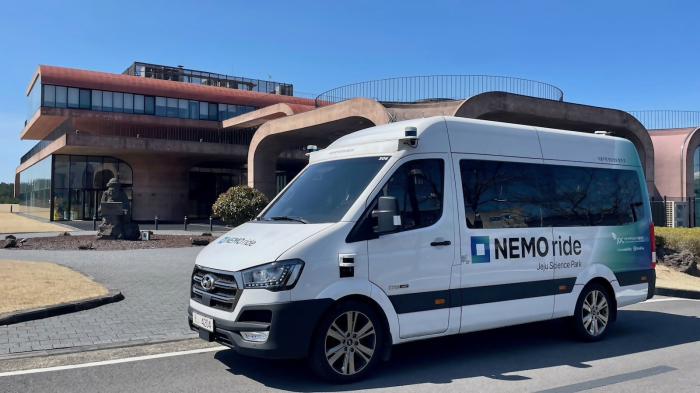RideFlux wins temporary Level 4 self-driving permit
The country expects to roll out commercial services of Level 4 autonomous driving as early as October of this year
By Jun 12, 2024 (Gmt+09:00)
South Korea’s Rznomics inks $1.3 bn out-licensing deal with Eli Lilly


Korea’s aesthetic medicine enjoys golden era with surge in foreign spending


In China’s waterway city Hangzhou, K-beauty redefines ‘shuiguang'


Kumho Tire shuts Gwangju plant after fire, derailing record sales run


When in S. Korea, it’s a ritual: Foreigners make stops at CU, GS25, 7-Eleven



RideFlux Inc., a South Korean autonomous driving technology startup, has received a temporary permit to operate a driverless car at normal speed for the first time in the country.
The permit paves the way for the commercialization of Level 4 autonomous driving services, which do not require a safey operator in the front seat, as early as October of this year, the Ministry of Land, Infrastructure and Transport said in a statement on Wednesday.
A sports utility vehicle (SUV) equipped with autonomous driving systems and radar sensors, developed by RideFlux, passed performance and safety tests in the country’s largest autonomous driving pilot zone in Hwaseong, Gyeonggi Province, in December of last year.
With a temporary license, the vehicle is allowed to drive on a 3.2-kilometer circular section of road within the autonomous test driving area in Sangam-dong, western Seoul. It can drive at a speed of up to 50 km per hour.
The SUV comes with automatic braking systems for emergency use and a maximum speed limit system, as well as emergency stop buttons.
Autonomous vehicles that have received temporary operating permits in South Korea are those with a test driver in the driver's seat, driverless cars operating at extremely low speeds of up to 10 km per hour, or special purpose vehicles such as garbage trucks.

The unmanned vehicle will undergo additional safety verification tests in two stages before its commercialization, which will take place under limited conditions, such as driving only in the designated area where the performance tests are carried out.
“If the driverless vehicle passes the additional safety tests, it will be able to start commercial services as early as October,” the ministry added.
The first stage of the autonomous driving test will be conducted with a test driver in the driver's seat.
For the second-stage test, the vehicle will be operated without a safety operator in the front seat. But a safety operator must be ready to take emergency measures through remote control inside or outside the car.
As demand for autonomous driving services is expected to rise, the transport ministry plans to develop detailed standards by the end of this year for the issuance of temporary autonomous driving permits.
Write to In-Hyeok Lee and Kang-Ho Jang at twopeople@hankyung.com
Yeonhee Kim edited this article.
-
 Future mobilityHyundai Motor’s IONIQ 5 robotaxi passes US driver’s license test
Future mobilityHyundai Motor’s IONIQ 5 robotaxi passes US driver’s license testApr 01, 2024 (Gmt+09:00)
4 Min read -
 Future mobilitySamsung hires Waymo’s autonomous driving design head
Future mobilitySamsung hires Waymo’s autonomous driving design headNov 15, 2023 (Gmt+09:00)
1 Min read -
 AutomobilesSelf-driving startup 42dot unveils driverless shuttle
AutomobilesSelf-driving startup 42dot unveils driverless shuttleSep 26, 2022 (Gmt+09:00)
1 Min read -
 Future mobilityKorea unveils autonomous driving, commercial drone service roadmap
Future mobilityKorea unveils autonomous driving, commercial drone service roadmapSep 19, 2022 (Gmt+09:00)
2 Min read -
 Future mobilityAutonomous driving startup 42dot plans Level 4 self-driving in Seoul
Future mobilityAutonomous driving startup 42dot plans Level 4 self-driving in SeoulDec 21, 2020 (Gmt+09:00)
1 Min read -
 Future MobilityKorea autonomous driving startup 42dot valued at $434 mn
Future MobilityKorea autonomous driving startup 42dot valued at $434 mnNov 01, 2021 (Gmt+09:00)
3 Min read


